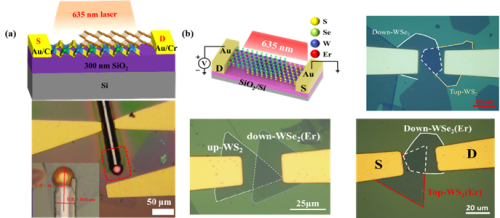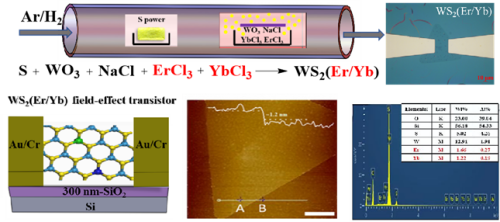

In recent years, Associate Researcher Xuan Shi from the Quantum Information Technology Center of Chongqing Institute of Green and Intelligent Technology (Chinese Academy of Sciences) and Professor Hongquan Zhao from University of South China have achieved multiple innovative results in the field of two-dimensional (2D) materials and quantum regulation. Their findings have been published in internationally authoritative journals such as Research, ACS Applied Materials & Interfaces, and Advanced Optical Materials. Through innovative doping techniques and heterojunction designs, the team successfully enhanced the photoresponse performance of 2D materials, laying a solid foundation for next-generation optoelectronic devices and quantum technologies.
Focusing on 2D Materials to Unlock New Dimensions of Optoelectronic Performance
The team has long been dedicated to coherent regulation of solid-state quantum systems and has made significant achievements in the preparation of 2D materials and device integration. By combining theoretical and experimental approaches, they proposed innovative heterojunction design schemes based on transition metal dichalcogenides (e.g., WS₂, GeSe). For example, in Er-doped WS₂ materials, high-concentration doping effectively suppressed tungsten vacancy formation, significantly improving the material’s light absorption efficiency and carrier mobility. This breakthrough provided a material basis for high-performance photodetectors, published in Research. Additionally, the team achieved broadband photoresponse in GeSe field-effect transistors with response speed and sensitivity reaching international advanced levels (ACS Applied Materials & Interfaces, 2019).

Figure 1. High-concentration doped WS₂(Er) 2D materials, GeSe field-effect transistors, and GeSe/WS₂(Er) thin-film heterojunction devices.
Quantum Regulation and Device Innovation to Advance Technological Applications
The team focused on optoelectronics research of 2D Dirac semiconductors, achieving breakthroughs in heterojunction interface regulation and device performance optimization. Their designed WS₂(Yb)/Te mixed-dimensional van der Waals heterojunction enabled efficient photoelectric conversion through interface band engineering, published in Advanced Optical Materials (2024). Furthermore, by employing rare-earth element doping strategies, the team successfully regulated the electronic structure and luminescence properties of WS₂/WSe₂ heterojunctions, boosting the device’s responsivity in the near-infrared band by several times (Materials Today Chemistry, 2024). These results provide critical technical support for fields such as optical communication and optical computing.

Figure 2. Various heterojunction devices based on high-concentration rare-earth-doped WS₂ 2D materials.
Industry-Academia Collaboration to Boost Industrial Upgrading
The team has long emphasized industry-academia cooperation. Their developed high-performance photodetectors and quantum regulation technologies have been collaboratively applied with multiple enterprises. For example, the ultrasensitive photodetector based on Er³⁺/Yb³⁺ co-doped WS₂ demonstrates excellent performance in weak-light detection, showing promise for applications in biomedical imaging and environmental monitoring. Additionally, the team’s participation in the Chongqing Natural Science Foundation project “Research and Application of Fluorescence Resonance Energy Transfer in Quantum Systems” is exploring innovative quantum technologies for biosensing and medical diagnostics.

Figure 3. Ultrasensitive photodetector based on Er³⁺/Yb³⁺ co-doped WS₂.
Paper Links:
https://pubs.acs.org/doi/10.1021/acsami.9b11132
https://spj.science.org/doi/10.34133/2022/9840970
https://advanced.onlinelibrary.wiley.com/doi/10.1002/adom.202102413
https://pubs.acs.org/doi/10.1021/acsami.3c08027
https://advanced.onlinelibrary.wiley.com/doi/10.1002/adom.202302229
https://advanced.onlinelibrary.wiley.com/doi/10.1002/admt.202302095
https://advanced.onlinelibrary.wiley.com/doi/10.1002/adom.202401724
https://www.sciencedirect.com/science/article/abs/pii/S0169433224000011?via%3Dihub
https://www.sciencedirect.com/science/article/abs/pii/S2468519424001836?via%3Dihub